Have you ever wondered how pearls are made?
If you like pearls, you may have heard that pearls can be made by inserting the nucleus into the Akoya oyster.
This time, I will introduce the stage before the nucleus insertion work, the preparation stage of the nucleus insertion.
In school exams, studying until then. Preparing ingredients for cooking, warming up before sports, etc.
Preparing to insert the nucleus into the Akoya oyster is also a very important task.
Even if you open the mouth of the Akoya oyster and insert the nucleus into it without any preliminary preparation, the Akoya oyster will spit out the nucleus in a few hours.
Even if an experienced nucleus inserter inserts the nucleus into a properly prepared Akoya oyster, a few percent of the nucleus is expelled from the Akoya oyster.
However, the chances of maiking a beautiful pearl without spitting out the nucleus during the one-year cultivation period are extremely low.
Now let’s talk about the preparations.
In Japanese, the preparatory work is called “Shi-tate”.
This is the meaning of “Tailoring” in English. Well-tailored clothes can be worn comfortably for a long time.
At first glance, there seems to be no relationship between oysters and clothes, but I think there is no problem if you imagine the nuances of tailoring clothes.
The purpose of tailoring in Akoya oyster,
1.To be in a state that can withstand nucleus insertion, which can be said to be surgery.
2.Make the shellfish have no eggs.
These two points are the main goals.
For Akoya oyster, the nucleus is like a big surgery to insert a softball into the body of a human.
Also, since the nucleus is put into the ovaries of Akoya oysters, if Akoya oysters have eggs, the pearls will become cloudy and stains will appear.
Let’s take a look at the size of the nucleus.
The units for measuring the size of the nucleus are ‘Bu’ and ‘Rin’.
1 Bu is 3.03 mm, 1 Rin is 0.303 mm.
The core sizes used to make 6, 7 and 8mm pearls are 1 Bu 8 Rin, 2 Bu 1 Rin” and 2 Bu 4 Rin ” respectively.
Using millimeters,
6mm→5.45mm,
7mm→6.36mm,
8mm→7.27mm.
For example, using a 5.45mm nucleus to make a 6mm pearl means [6 minus 5.45=0.55 ]
Since the nacre overlaps the whole, it is half that, 0.275 mm
When the nacre layer rolls up, it becomes a 6mm pearl. General pearls have a nacre layer thickness of about 0.4 mm, so a nacre layer of 0.275 mm
It’s not that difficult.

Regarding this difficult unit, even Japanese people do not use it in their daily lives. Is it used in baseball batting average?
The culture method of Akoya pearls was established in Japan and has been exported all over the world.
There is also a history of confusion caused by changing the unit of weight of pearls, “mommme”, to grams in the past.
“Momme” is still used today.
1 momme(匁) is 3.75g.
A 6mm size pearl weighs 0.1 momme (0.375g).
A 7mm size pearl is 0.15 momme (0.562g).
A 8mm size pearl is 0.20 momme (0.75g)
In wholesale, pearls are often traded by weight, so the number is not counted. However, on rare occasions when I do business with how much each pearl is, I count the numbers.
Even in units of 1,000 pieces, each 7mm size weighs 0.15 momme, so there is almost no error. Pearl weights seem to be fairly accurate.
Okay, let’s stop talking about pearl nucleus.
I will continue the story about the Shi-tate of Akoya oysters.
There is an important purpose in tailoring Akoya oyster, “to make it a state without eggs”, but in order to achieve such a state, there are two main types of methods. There are two processes, depending on whether the pearl oyster has eggs or not.
Since the nucleus insertion into Akoya oysters starts in April every year, I will start by explaining the Shi-tate of the Akoya oysters that will be nucleus-inserted in April.
By the way, the reason why the nucleus insertion work starts in April is that the seawater temperature needs to be 14 degrees or more for the Akoya oysters to be active. Akoya oysters don’t like the cold, may be.
If the seawater temperature is below 13 degrees, the Akoya oyster are almost inactive. If we put the nucleus into the Akoya oyster in such a state, the life of the Akoya oyster will be in danger, and we can never hope for a beautiful pearl. Recently, due to the rise in seawater temperature, there are some farms where the nucleus is inserted even in March, but it seems to be still a rare case. According to the fixed point observation of the pearl farm, the average sea temperature in April 2014 was 14.02 degrees, and in April 2022 it was 16.8 degrees.
It seems that the seawater temperature is rising year by year, so the timing of the nuclear insertion work may change in units of several decades.
Now, preparations for oyster to be nucleated in April begin around October of the previous year. Akoya oysters without eggs are packed in a black plastic box. In the case of Akoya oysters with eggs, release them by using an ozone generator. (The ozone generator will be explained later.)
The inside of the box is like a crowded train, so the activity of the Akoya oysters are suppressed. Just to be sure, there are very few Japanese people or Akoya oysters who like crowded trains.

The size of the black box is about 50-50-30 cm, and there are some gaps in the box, and it can be put a lid on it. There is little food in the box, it becomes difficult to breathe, and the Akoya oysters go into hibernation. And that state will continue until spring without eggs. In this way, the Akoya oysters to be used in April are prepared from October of the previous year. Akoya oysters, which do not have eggs, are packed in boxes to suppress their activity. In mid-April, when the water temperature exceeds 14 degrees, we will start inserting nuclei. These processes are called “suppression”「Yoku-Sei」. It means to suppress it so that it does not have eggs.
It is a term often used among pearl farmers.
“When is this Akoya oyster?” “It’s suppression.”
This is about Akoya oyster that have already been nucleated, when did you nucleate them? question and the answer to it.
If they hear “suppression”, they can understand that “I see that they insert the nucleus in the spring.”
Until around May and June, we will use the above-mentioned suppression oysters.
You might think it would be easy to put it in a black box and leave it until spring. Certainly, if the number of Akoya oysters are about 10, it seems that it will not be difficult to manage them one by one. The company I work for has a pearl farm that sometimes handles 40,000 oysters a day. We have about 30 employees. For example, if 40 oysters are packed in a black box, the weight will exceed 4 kg. When handling 40,000 oysters, the number of boxes will be 1,000 boxes.
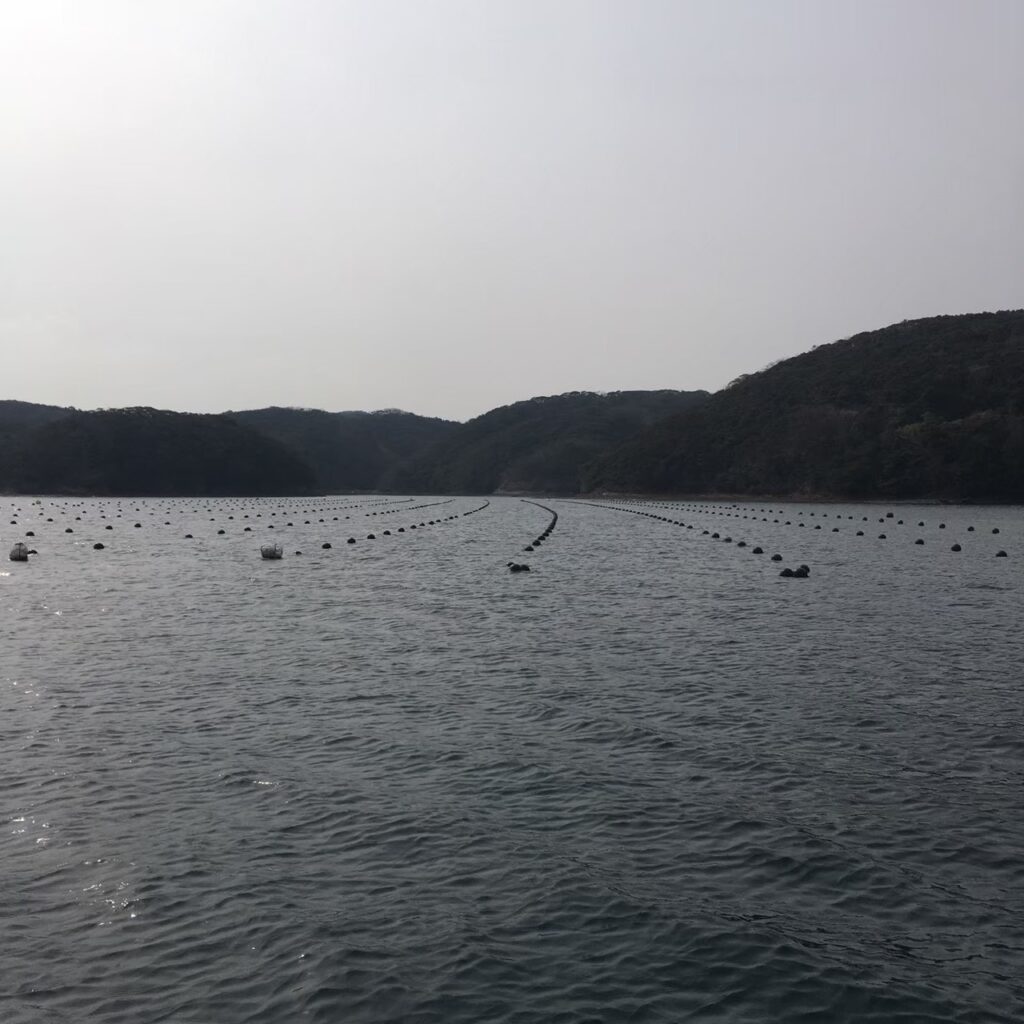
To pack oysters into a black box, we start by collecting oysters. A small boat leaves the sea off the farm. In the farm where pearl oysters are hung, several 100-meter long ropes are stretched parallel to each other in the sea. Nets containing Akoya oysters are hung on the rope at intervals of 1.5m. One net contains about 30 Akoya oysters. This weight is also about 4 kg. The boat is laid alongside the rope, and the net is pulled from the rope and loaded onto the boat. The speed of the rope that can be pulled is about the speed of a short run. Two skilled workers load the nets onto the ship one after another. 150 nets are loaded onto the ship in minutes. It’s a small ship that can’t carry more than that. I participated several times, but I had to stop many times because I could not untie the net from the rope immediately. I’m half-assed while working, and the edge of the ship is just below my knees, so I have a fear of falling into the sea. Each net was so heavy that my body screamed when I pulled up even 50 nets.
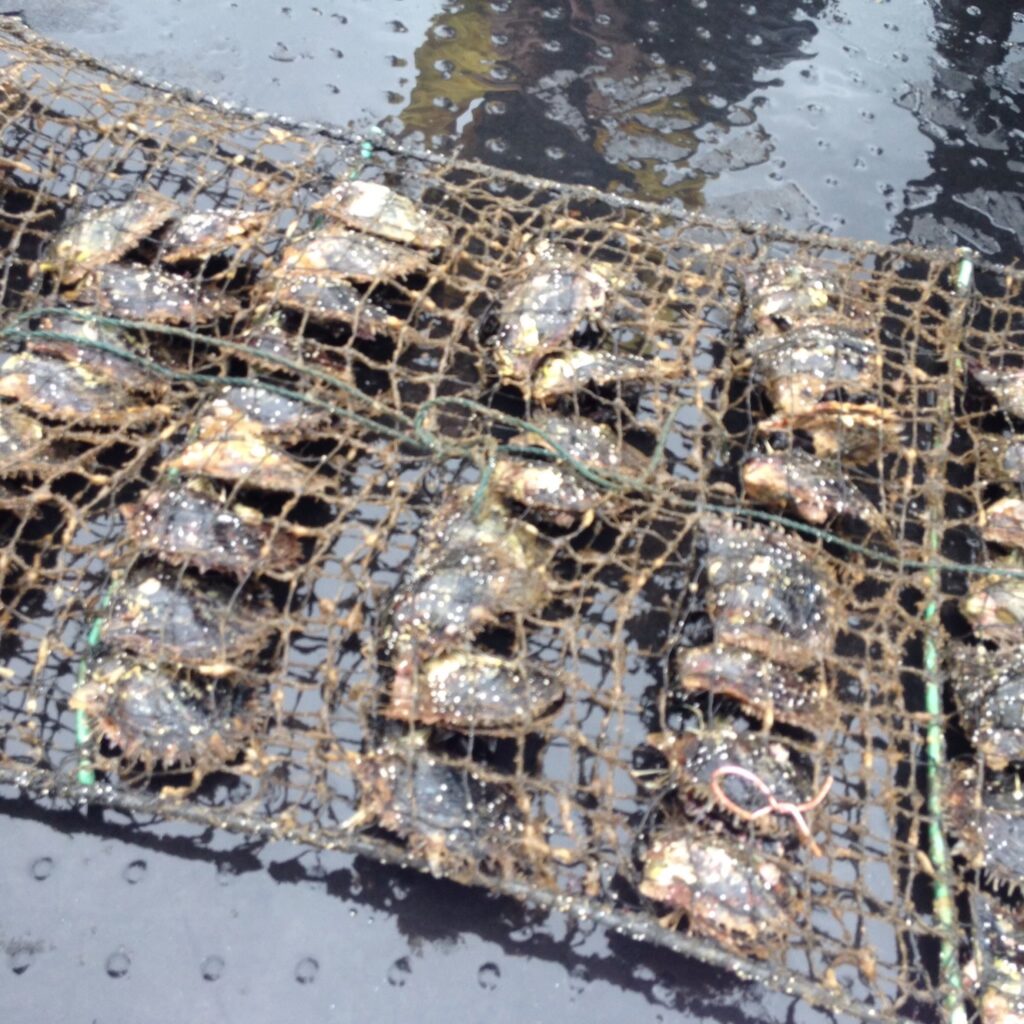
In this single process, 4,500 Akoya oysters are transported to the workshop. A workshop is like a house floating on the sea. When the nets are brought to the workshop, one worker earnestly takes the Akoya oysters out of the net onto a large table that serves as a workbench. This person will spend most of the day working on putting the clams on the table. Various creatures living in the sea cling to the surface of the Akoya oysters served on the table. It is a natural enemy that steals food such as plankton that Akoya oysters normally eat. There are various creatures such as Oysters(Not Akoya oysters, just Oysters), barnacles, and Christmas tree worm etc. Several workers use spatulas and electric hand grinders to clean the Akoya oysters. The cleaned Akoya oysters are moved back and forth on the table and then sorted into large, medium and small sizes. In addition to large, medium and small Akoya oysters, malformed and weakened Akoya oysters are removed. By sorting the Akoya oysters by size, it is possible to smoothly use the nucleus of the planned size during the nucleus insertion work. Akoya oysters become more active when the water temperature is high, and are less active when the water temperature is low. This amount of activity is proportional to the amount of pearls(nacre) secreted by Akoya oysters. When Akoya oyster activity is low, such as in spring and autumn, and the Akoya oyster does not secrete much nacre, we let the oyster do its best with a slightly smaller nucleus. And when the Akoya oysters are active, such as in summer, we want them to secrete a lot of nacres by inserting a large nucleus into the Akoya oysters. At the pearl farm, we plan the size of the nucleus on an annual basis, taking into account such seasonal climate. It can be said that regular sorting by size of Akoya oysters is an important task for that plan as well.
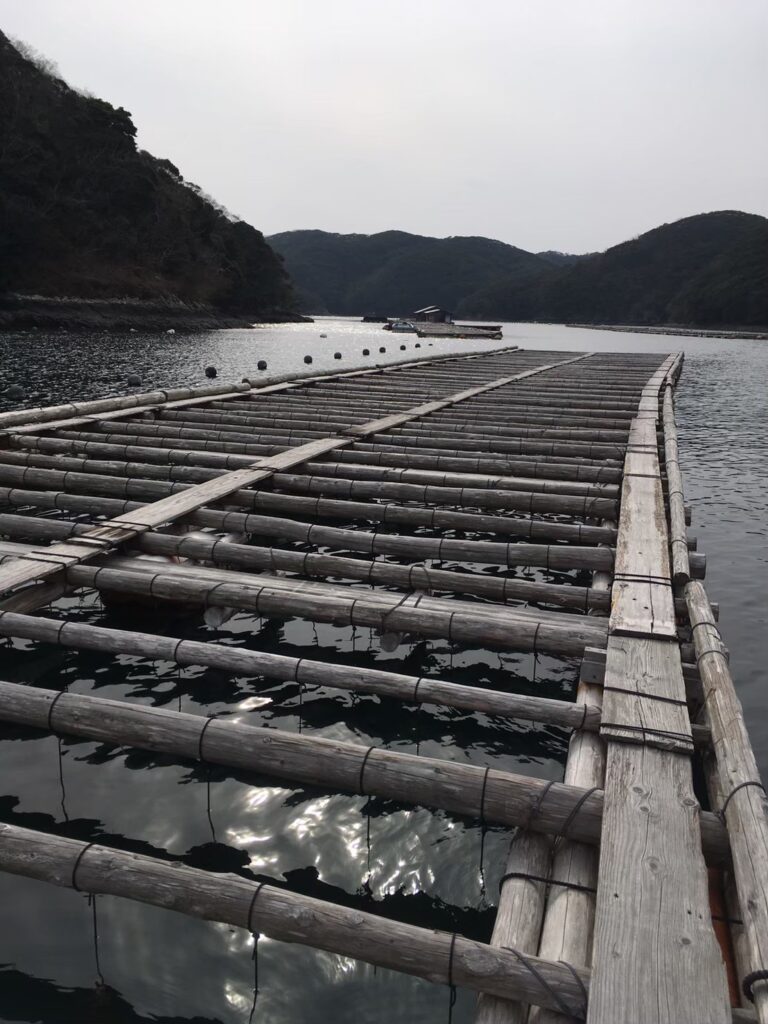
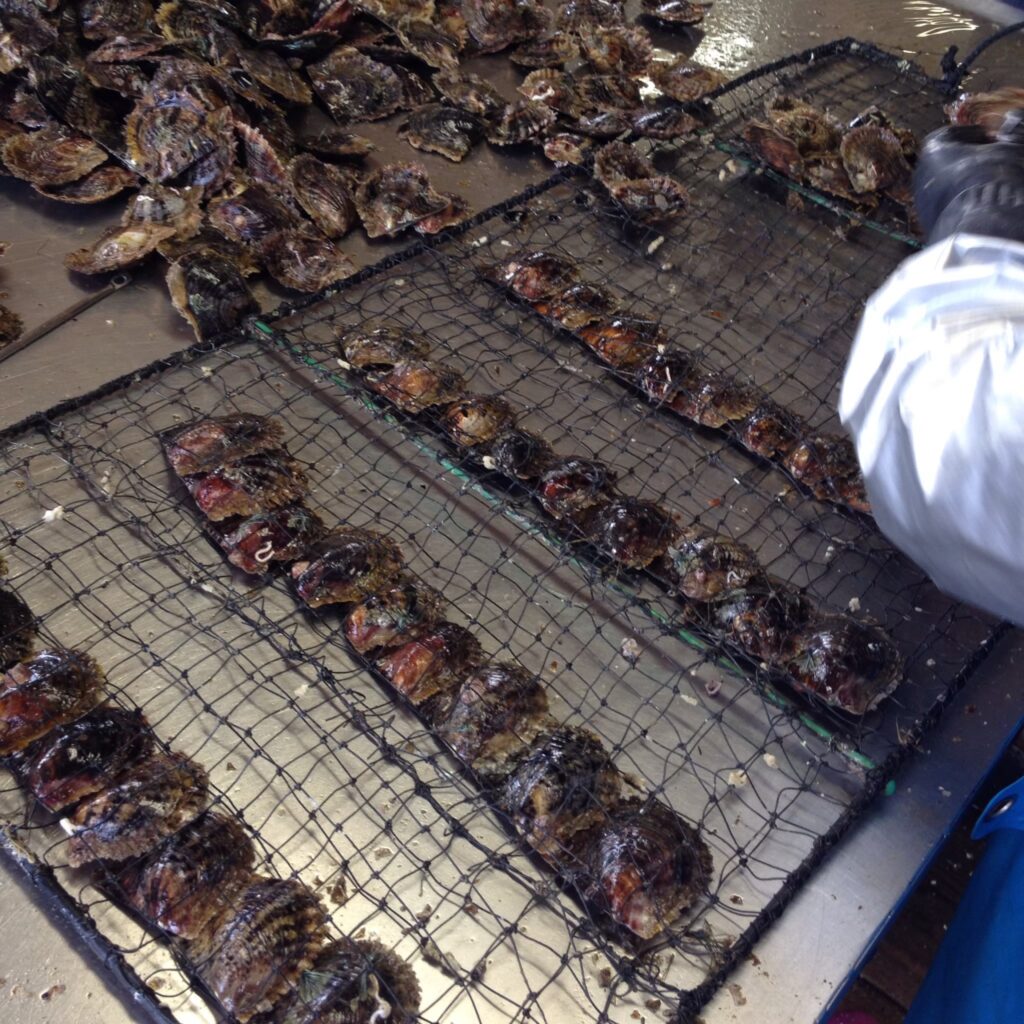
Go back to the workshop table. The selected Akoya oysters are finally placed in a black box. They are neatly arranged and each box is carefully made. Boxes filled with Akoya oysters quickly occupy a corner of the workshop. The two people who have the role of going offshore to collect Akoya oysters also have the task of returning this box to the sea. Load more and more on the ship and carry it to the designated raft. Each one is tied to a rope and sunk into the sea. If they don’t finish it quickly, the workers who clean the Akoya oysters will rush them to say, “There will be no Akoya oysters!!” They hurried out to sea from the pearl farms and loaded many more nets onto the boats to take them to their homes on the sea.
This kind of work continues for more than two weeks in order to prepare Akoya oysters used in the spring. No job is easy, but pearl farming is hard work too.
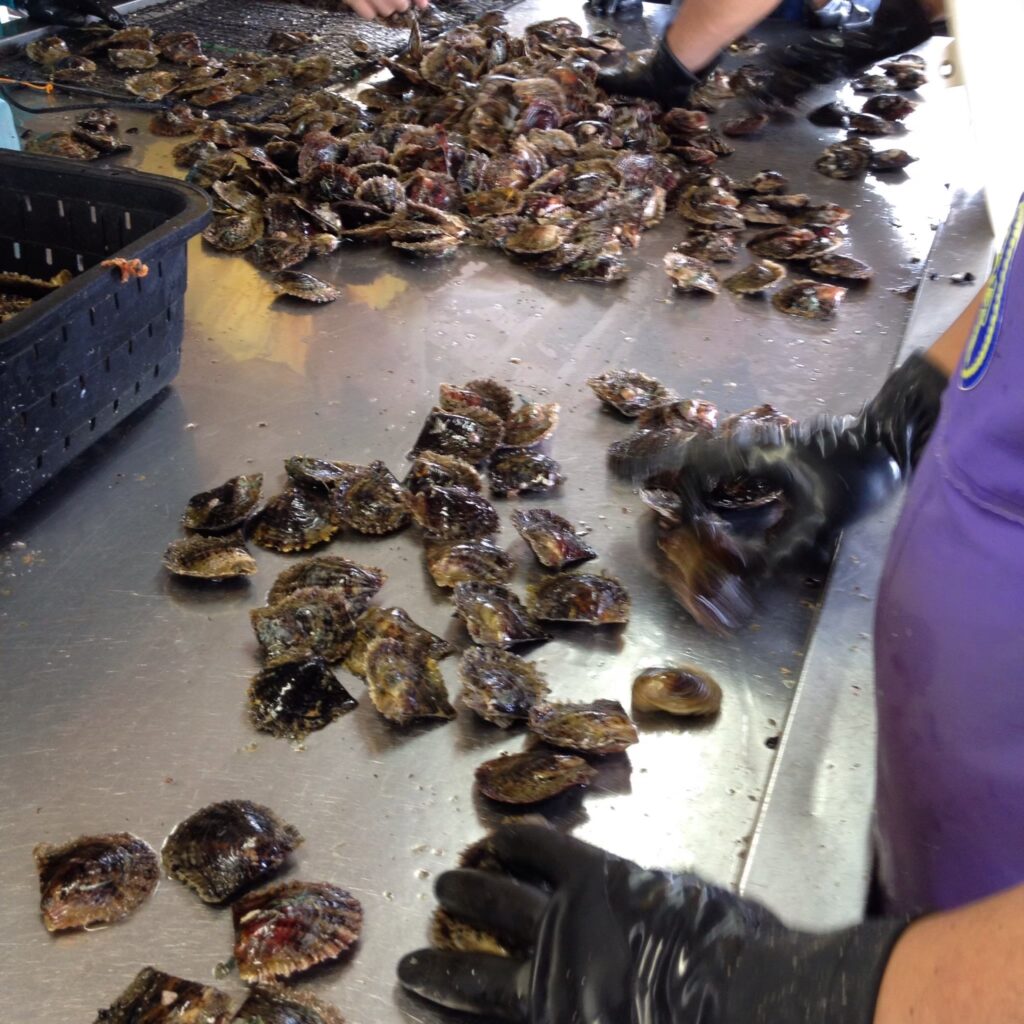
Let’s take a look at the Akoya oysters that we use next to suppression Akoya oysters. suppression Akoya oysters is used until about June. The spawning season of Akoya oyster is from May to September.
Even if we try to insert the nucleus into the Akoya oysters in June, there is a high probability that Akoya oysters will have eggs. How do we release eggs from Akoya oysters that have eggs? The method of releasing is also similar to ‘suppression’. Akoya oysters are packed in a black box to reduce their activity for about 2 weeks. At this time, the Akoya oysters are suspended at a depth of 6 meters, but after two weeks of processing, it is pulled up to 3 meters. As the seawater depth becomes shallower, the sea temperature rises, and the Akoya become energetic, and the eggs are released with that momentum. Keep this condition for 2 weeks. After releasing all of it, it is submerged again to a depth of 6 meters. Then, they rest there for another two weeks and are transported to the nuclear insertion work. If it does not spit eggs even if it is raised to the 3m position, it is submerged again to 6m and the process is repeated. The head of the site calculates the weather and the condition of the Akoya oysters, and adjusts the process, which takes more than a month, to the time when we want to insert the nucleus. If we want to insert the pearl nucleus in the first week of June, we may start preparing from the second half of April. 2 weeks can be 7 or 10 days depending on Akoya oysters and weather.

More than 10,000 Akoya oysters are required for nucleus insertion per day. For one week, 70,000 Akoya oysters are required. For more than a month, the Akoya oysters are made to spit out the eggs they hold in various ways, and they are brought to the best condition and brought to the nucleus insertion process. If we just make the Akoya oysters vomit the eggs, they will release the eggs if we hurt the Akoya oysters. However, as explained at the beginning, nucleus insertion is a major operation for Akoya oysters. If the Akoya oysters are weak, they cannot be operated. It is necessary to reduce the activity of the Akoya oysters to the extent that their physical condition improves, make them vomit eggs, and give them proper medical treatment. Opinions differ depending on the pearl farmer about this work. There are opinions such as 「the egg needs to be thoroughly vomited」and 「the egg should remain a little.」In addition to this, the characteristics of Akoya oysters and the trends among pearl farmers are changing year by year and there are various opinions.
An experienced piano tuner (technician) will change the tuning according to the habits of the person who plays the piano. It seems that the keyboard is tuned according to the person’s habit, such as a soft touch or a strong touch. In addition, it seems to calculate the environment such as humidity and acoustics of the hall where the performance is actually performed. It’s a completely different field, but I personally feel that there are some commonalities.
Also, a well-tailored (Shi-tate) Akoya oyster has a much higher chance of producing beautiful pearls, whether they are a newcomer or a veteran. That means that even a veteran has a much lower chance of producing beautiful pearls if the tailoring (Shi-tate) fails.
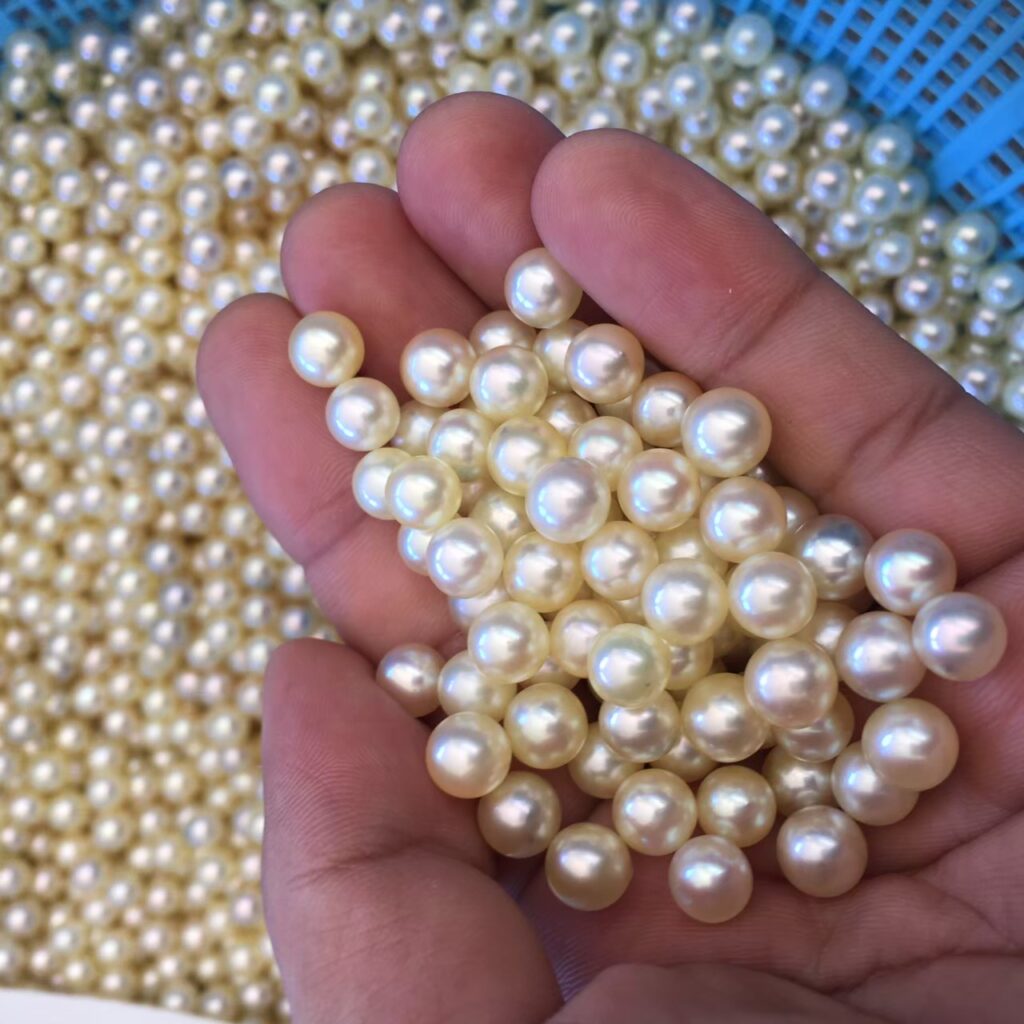
At the pearl farm, some of the harvested pearls are properly sorted for each individual so that they can look back on their achievements and improve their skills.
I look at them every year, and all the lots with bad grades are generally bad grades. Pearls with nuclei inserted by veteran workers have good results among them, but it can be said that the tailoring (Shi-tate) of Akoya oysters determines the results of pearls rather than individual nucleus insertion techniques.
The tailoring (Shi-tate) of Akoya oysters in June and July is one of the most difficult among the tailoring (Shi-tate) from April to December. This is because it is difficult for Akoya oysters to release eggs. As Akoya oysters, it may be the time when they want to spat eggs after the sea temperature rises a little more.
Let’s take a look at the tailoring (Shi-tate) after August.
From August onwards, the water temperature reaches nearly 30 degrees Celsius, making it easy for Akoya oysters to spit eggs. However, it is not completely exhausted.
In that case, put it in a black box like June or July.
And when summer passes, the seawater temperature will drop little by little. When the water temperature drops, Akoya oysters will not spit eggs easily again.
In such a case, use an “ozone generator”. Akoya oysters are placed in a heated pool with a diameter of about 5 meters, and the Akoya oysters are made to vomit eggs. Akoya oysters tend to spit eggs as a physiological phenomenon when the temperature reaches the right temperature for Akoya oysters. “Ozone generator” is used all day long, but if the Akoya oysters do not lay eggs, ozone is used until midnight. In the middle of the night, the field manager goes to the farm in the dark to turn off the “Ozone generator”. There are also a lot of Akoya oysters that need to be taken care of.
This ozone generator can be used in June or December depending on the weather and needs. In fact, it seems that it is better to let the egg vomit by the power of nature. However, in many cases, the power of nature alone is not enough, so ozone is often used in recent years. The head of a certain field thinks that the quality of pearls has deteriorated a little since they started using ozone. He says ‘I really don’t want to use it, but now I can’t go back.’ sometimes he says to himself. I got the impression from those words that I can get a glimpse of the various conflicts, hardships, and experiences involved in pearl farming.
‘Ozone’ activity will increase in November and December. This is because the seawater temperature is getting colder and colder. Until a few years ago, I had the impression that the pearls that were nucleated in November or December did not produce much nacre. However, in recent years, due to the rise in seawater temperature, many pearls with much nacre layers have been produced. Every year, nuclear insertion work continues until mid-December. For that time, many Akoya oysters are still waiting in the sea. It could be the Akoya oysters that will be used in December, or the Akoya oysters that will be used next spring.
In addition, there are many Akoya oysters that were just born this year and will be incorporated into the tailoring (Shi-tate) rail next year.
More than 3 million Akoya oysters are suspended in the vast sea, which can fit nearly 80 baseball stadiums. The on-site manager knows when to insert the nucleus for all Akoya oysters and when the nucleus has been inserted.
It was mid-January a few years ago. I went to the pearl farm office early in the morning for sorting pears. It was an unusual day with a lot of snow. Other employees are working outdoors in the cold to extract pearls from Akoya oysters. It was just me and the manager in the office. After I gave my morning greetings to him, I said ‘It’s unusually snowy, isn’t it?”
Looking out at the sea, the manager muttered, “It must be cold.” I thought it was a word directed at an employee working in the field, and I said, “It must be hard because their hands are numb in the cold.” The manager said, “I don’t worry about humans. If it’s cold, we can say it’s cold. But Akoya can’t speak words.”
It seemed like he was worrying about his own child who lives alone far away.
The craftsmanship of Akoya oysters, which are silent and do not show their emotions, is carried out while staying close to them every day.
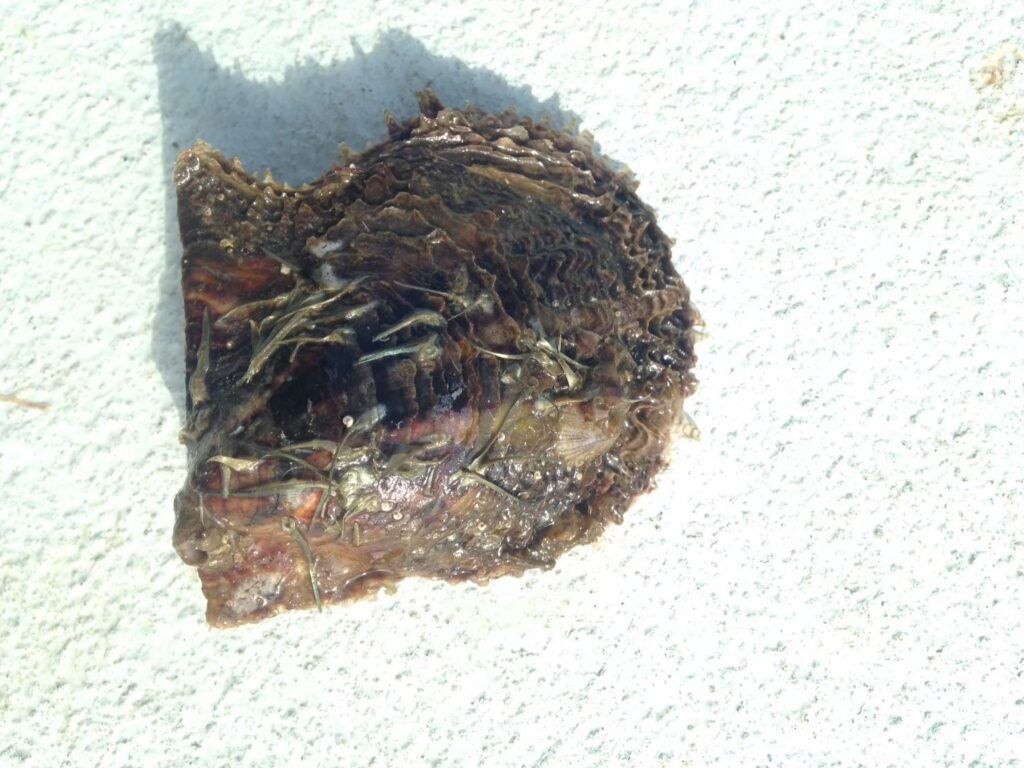

Comment